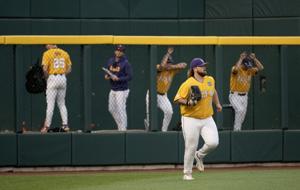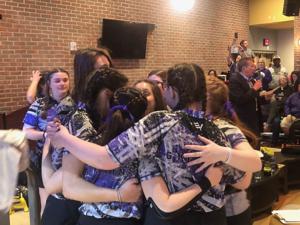
OMAHA, Neb. — In the top of the 11th inning Thursday night, minutes before Tommy White hit the home run that sent LSU to the College World Series finals, sophomore pitcher Thatcher Hurd had to work out of a jam.
Wake Forest threatened to break the scoreless tie with runners on first and second and two outs. Star third baseman Brock Wilken walked to the plate with his 31 home runs, tied for the most in the country, and Hurd missed the zone with his first pitch.
On the second, freshman pitcher Gavin Guidry said, Hurd threw a fastball down the middle, a spot usually best to avoid. Wilken launched the ball high in the air toward center field. He had swung too far underneath the pitch, and wind blowing into Charles Schwab Field turned the ball into a harmless out.
“You don’t have to be perfect,” Guidry said. “It’s hard to hit here. That’s the message that’s been relayed to us. Just go out there and compete in the zone.”
So far in this College World Series, LSU perfectly has approached the ballpark and conditions that neutralize most power hitters. The pitchers are exuding confidence, partially because of the wind, and the staff has become a strength heading into Game 1 of the national championship series at 6 p.m. Saturday against Florida.
Through five games, LSU’s pitchers have allowed eight runs over 46 innings for a combined 1.57 ERA. They already completed two shutouts, the most in team history at a single College World Series, and threw 18 straight scoreless innings in two elimination games against Wake Forest.
Only once in 18 previous trips here had the Tigers pitched a shutout, and that came in the 1993 final against Wichita State. Rosenblatt Stadium was friendly to hitters, but LSU had played 12 games in this park without throwing a shutout.
“We’re executing at a high level,” Guidry said.
Part of the reason stems from an ability to pitch to the ballpark. Players said since advancing to the CWS, pitching coach Wes Johnson has harped on throwing strikes because of how hard it would be for hitters to clear the fence if the wind was blowing into the stadium.
He wanted them to “dominate over the plate,” freshman Griffin Herring said, knowing they would get outs if they peppered the strike zone. LSU has walked only 17 batters while striking out 60 and allowing an average of 5.6 hits per game.
“The big park played in my confidence just to be able to fill up the zone, trust my pitches with weak contact,” Riley Cooper said after a 5-0 shutout of Tennessee on Tuesday. “Even if they got into it, it’s really hard to hit it out of the park.”
Cooper pitched three scoreless innings in the first shutout in relief of Nate Ackenhausen. Ackenhausen had not started since transferring to LSU. He made his longest appearance of the season, throwing 93 pitches over six innings.
“I get a 2-0 changeup call,” Ackenhausen said, “and I’d just throw it down the middle and say, ‘Let them put it in play,’ because you’ve seen some balls hit today that were about 108 (mph) off the bat and they were kind of at the warning track.”
All of this comes after LSU’s pitching staff, aside from ace Paul Skenes, seemed like a weakness for part of the season. It struggled at times after injuries to Garrett Edwards and Chase Shores, particularly in back-to-back series losses to Auburn and Mississippi State last in the season. Questions swirled around the pitchers heading into the postseason.
“Mistakes happen,” junior catcher Alex Milazzo said. “There was probably a two-week stretch, and people started labeling them as a bad staff. But they didn’t stop believing in themselves. We didn’t stop believing in them. And neither did our coaches.”
The pitchers must continue to execute for LSU to win its first national title since 2009. Skenes likely can’t return until Monday at the earliest after throwing 120 pitches against Wake Forest, leaving the rest of the staff to get through the first two games against a rested Florida team that can arrange its starters in their typical order.
Although LSU coach Jay Johnson declines to reveal who will pitch before games, he charted how LSU would get through the championship series after it fell into the losers bracket. He presented the plan before the Tigers’ first elimination game, writing out all the days they would have to play on a whiteboard.
Johnson wrote Ackenhausen’s name with eight other relievers underneath Tuesday. He drew lines from that group to Wednesday against Wake Forest. He wrote down Skenes’ name under Thursday, and he had the plan for the three championship games. Johnson asked whether anyone on the team had a question, and they boarded the bus.
“I think there’s a pathway for them if they execute to be successful,” Johnson said. “And it really doesn’t matter what I think or feel about it. We are where we are. We earned our way here the way that we did. And so now we have to go with how we’re set up.”




Leave a Reply